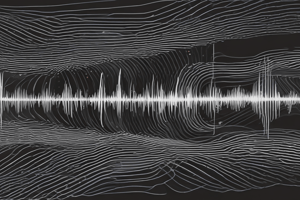Podcast
Questions and Answers
What is the speed of sound in air at 0°C?
What is the speed of sound in air at 0°C?
- 330 m/s
- 331 m/s (correct)
- 332 m/s
- 333 m/s
How much does the speed of sound in air increase per degree Celsius?
How much does the speed of sound in air increase per degree Celsius?
- 0.8 m/s/°C
- 0.7 m/s/°C
- 0.6 m/s/°C (correct)
- 0.5 m/s/°C
What does the variable T represent in the speed of sound equation?
What does the variable T represent in the speed of sound equation?
- Time in seconds
- Total energy in joules
- Temperature in Kelvin
- Temperature in degrees Celsius (correct)
If the temperature of air increases, what happens to the speed of sound?
If the temperature of air increases, what happens to the speed of sound?
Calculate the speed of sound at a temperature of 25°C using the equation provided.
Calculate the speed of sound at a temperature of 25°C using the equation provided.
Study Notes
Speed of Sound in Air
- The speed of sound changes with environmental factors: wind, temperature, and humidity.
- It remains unaffected by properties of sound like loudness, intensity, and pitch.
Temperature's Role
- Temperature is defined as the average kinetic energy of particles in a substance.
- Higher temperatures lead to increased particle movement, resulting in faster sound speed.
- Sound is characterized as vibrations traveling through particles in a medium.
Speed of Sound Calculation
- Speed of sound in air at 0°C: approximately 331 m/s.
- The speed increases by approximately 0.6 m/s for each degree Celsius increase in temperature.
- Formula: 𝑣 = 331 m/s + 0.6 m/s/°C × T, where T is the temperature in °C.
Example Calculation
- To find the speed of sound at 25°C:
- Insert T = 25°C into the equation:
- 𝑣 = 331 m/s + (0.6 m/s/°C × 25°C)
- Resulting calculation yields an increase of 15 m/s.
- Final speed of sound at 25°C: 346 m/s.
Studying That Suits You
Use AI to generate personalized quizzes and flashcards to suit your learning preferences.
Description
This quiz explores the relationship between temperature and the speed of sound in air. It discusses how various factors, including humidity and wind conditions, influence sound speed while distinguishing it from loudness and pitch. Test your understanding of these concepts.




